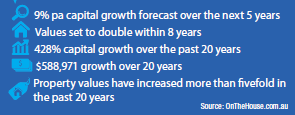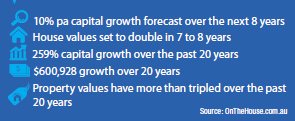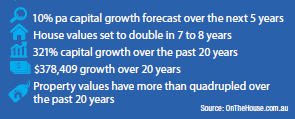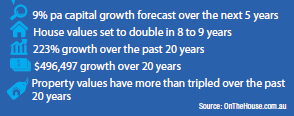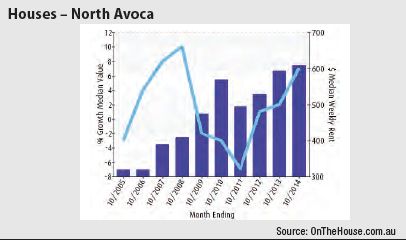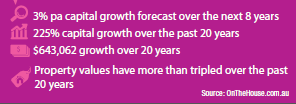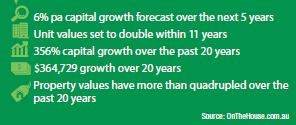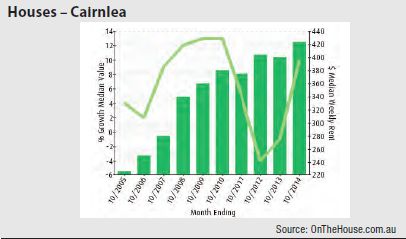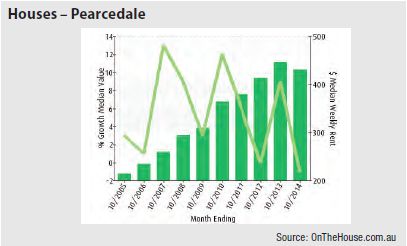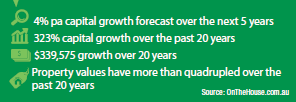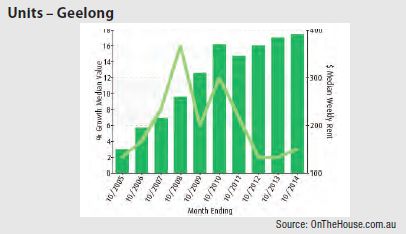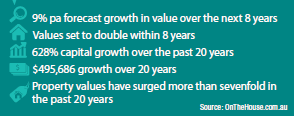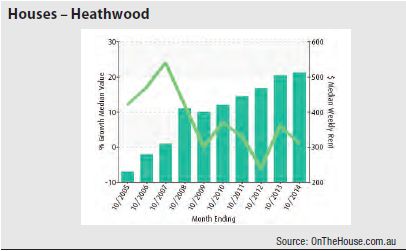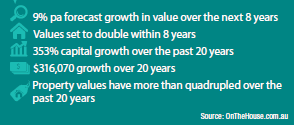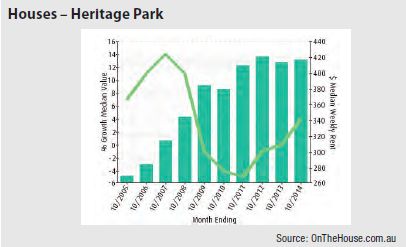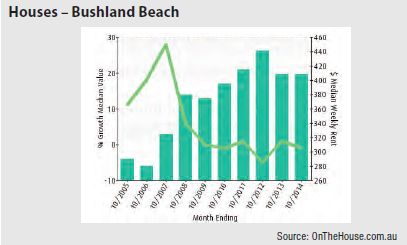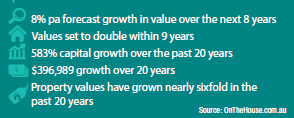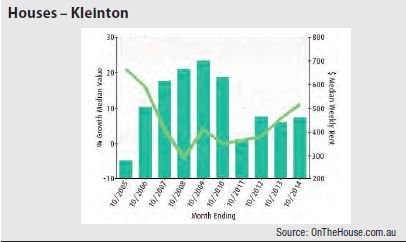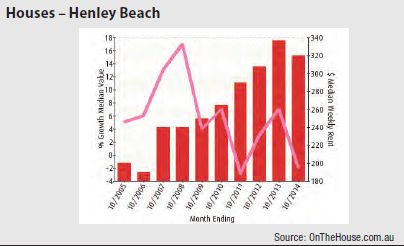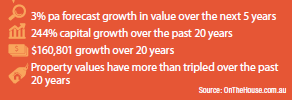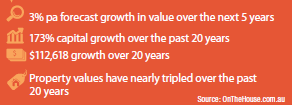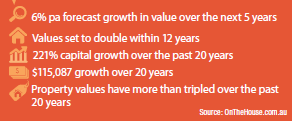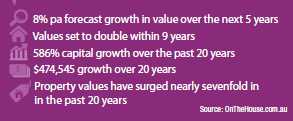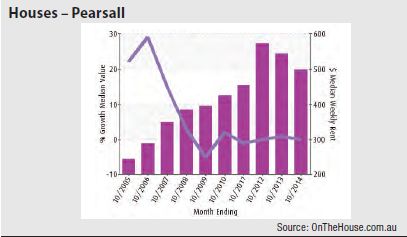Finding areas set to grow in value has become more challenging since the recent strong growth spurt in many markets. But they do still exist if you know where to look. And if you’re wondering where you could make big, fat profit in the medium to long term, you may want to check out the following suburbs, which are fully vetted and analysed by the experts at OntheHouse.com.au.
1. Glenwood (Sydney) – Houses
Growth triggers
- There is a shortage of housing supply in relation to buyer demand. There is currently just 0.64% of stock on the market, and properties spend an average of only 31 days on market, indicating strong demand for limited stock.
- The demographic is relatively affluent, with the median weekly household income sitting at $2,192. This means residents can afford increases in both rents and property prices.
- The fast-growing Norwest Business Park sits on Glenwood’s border. This is generating economic and employment growth
- Glenwood will benefit from development of the North West Rail Link. Commuting to the Sydney CBD is expected to get much easier, thus boosting the convenience of its location.
- This suburb is in the Blacktown LGA. Blacktown is one of the fastest-growing areas in NSW.
2. Woronora Heights (Sydney)– Houses
- Demand for properties hugely outpaces supply, as shown by the quick turnover of stock on market. Properties spend an average of just 32 days on market, and rental vacancies are zero. As there is limited stock on market (0.59%), solid growth is on the cards within the next seven years.
- Woronora Heights is considered an affluent area, as shown by the median weekly household income of $2,581. It’s a highly desirable suburb and considered relatively safe. This feature attracts families and is good for growth.
- Reliable public transport and proximity to the Bangor Bypass mean easy access to employment hubs. As Sydney pushes outwards, this will benefit the suburb.
- Sitting 29km from the Sydney CBD but surrounded by bush, Woronora Heights has increasing appeal for those looking for a non-urban lifestyle within reach of the city.
- Local council development spending should impact positively. There are plans for a youth recreational facility in the suburb and an urban activation precinct nearby.
3. Bolwarra Heights (Regional NSW) – Houses
- Median house values have fallen during the last 12 months, but the long-term performance of the suburb is pretty solid. The more affordable price point is likely to attract buyers into this highly desirable suburb.
- Bolwarra Heights has a relatively affluent demographic, earning a median weekly income of $1,934, which is 56% higher than the median weekly income for the state.
- It sits beside the Maitland CBD, which is the service centre for the Hunter region’s agricultural hinterland. As the regional economy picks up, the CBD will benefit – and so with both a freeway and the Maitland Airport nearby, Bolwarra Heights has straightforward access to both Newcastle and Sydney. This means commuting is possible.
- Families dominate this suburb. This tends to lead to local infrastructure investment, which further enhances the appeal of the area.
4. North Avoca (Regional NSW) – Houses
- The suburb has a relatively affluent demographic earning a median weekly income of $1,791, which is $554 higher than the state median. This means residents have the capacity to afford higher rents and property prices.
- Prices have grown solidly during the past 12 months, but demand continues to rise as shown by the high number of people (66 per listed property) searching online for properties in the suburb.
- In Gosford, there is a significant amount of development going on, including the major Kibbleplex project. Employment opportunities are on the rise, which boosts interest in property.
- North Avoca sits halfway between Sydney and Newcastle, so it is possible to commute to either. As major price growth in the cities pushes buyers further out, this location will be increasingly popular.
- This is a highly sought-after area, thanks to the lifestyle component of this coastal suburb.
5. Deakin (Canberra) – Houses
- The suburb is showing limited supply and defying the general oversupply trend in the ACT. Currently there is only 0.64% of stock on market, indicating limited supply of housing. As confidence and stability return to the ACT market, this shortage is likely to create demand
- This is a well-established and highly desirable suburb, which ensures long-term demand.
- With a median weekly household income of $2,512, Deakin’s residents are earning $595 more each week compared to the ACT median. This means residents can afford rises in rent and in property prices.
- As it sits close to the Canberra CBD and in the ‘parliamentary triangle’, there are strong economic and employment hubs in the vicinity. As the ACT economy picks up again, this will benefit Deakin.
- It has excellent access to amenities and services. As the federal capital, Canberra is home to many diplomatic visitors, which make this an attractive feature.
6. Windsor (Melbourne) – Units
- With just 0.22% of stock on the market, supply in Windsor is tight and local agents say demand is increasing. Currently, there are 63 people searching for every listed property.
- Property prices haven’t grown strongly yet, with just a 4.81% value increase in the past 12 months. Compared to the suburb’s long-term growth rate of 7.89%, this means values have plenty of scope to grow strongly over the medium to long term.
- Given its prime location and proximity to the Melbourne CBD, prices in the area remain affordable – the median unit price of just $467,000 is less than half the typical house value of $925,000.
- Desirability of the suburb is shown by the solid increase of 10.57% in population between 2006 and 2011, according to ABS data.
- Gentrification has also started, with the local council planning a revitalisation of the main street shopping district and a $1m development of Windsor Plaza.
7. Cairnlea (Melbourne) – Houses

- Between 2006 and 2011, Cairnlea recorded spectacular population growth of 45.61%. This is a solid indication that demand is rising strongly too.
- This is a desirable location at just 17km from the Melbourne CBD. It’s also easily accessible via the Western Ring Road, and the suburb is close to several train stations, making it attractive to commuters.
- Affordability is a strong draw and is set to attract buyers who are priced out of the inner-city suburbs.
- Built from the late 1990s on, Cairnlea is a new suburb. But it is well planned with a good range of amenities and lifestyle options, which add to its appeal.
8. Pearcedale (Regional Vic) – Houses
- Demand for properties in Pearcedale is hugely outpacing supply. Vacancies are practically non-existent at 0.5%, and the auction clearance rate of 100% shows demand is high. At the same time, there is limited housing supply, with 0.48% of all stock up for grabs.
- Located on the Mornington Peninsula and 49km from Melbourne, the suburb enjoys good freeway links, making it a good commuter base for people who are being priced out of the inner city of Melbourne.
- It has a self-contained, agriculturally based economy, which is a solid employment driver.
- The local council starts construction of the $125m Casey Cultural Precinct development in 2015. It will attract workers to the LGA and boost the local economy on an ongoing basis.
- Prices are still well below their long-term average growth, which indicates there’s plenty of scope for values to rise still, especially at the current affordable price points.
9. Geelong (Regional Vic) – Units
- Geelong is Victoria’s largest regional city, but it is also just 72km from Melbourne. This proximity to the state capital, combined with the lifestyle attractions of a smaller, coastal city, mean it is becoming increasing popular with commuters.
- Not only does the city function as a major rail and road transport hub, but it also has a port. These are solid economic drivers.
- Geelong’s city council is actively encouraging business development in the city. This should lead to more employment opportunities and attract more people.
- As home to Deakin University and a TAFE, the city attracts those wanting to study. This makes for a healthy rental market – in fact, 41% of households are renters – and encourages investors.
- Affordable prices mean it is a viable alternative to Melbourne, especially as prices continue to rise.
10. Heathwood (Brisbane) – Houses
- Affluent demographic earns a median weekly income of $2,229, which means they can afford further increases in rent and property prices.
- Heathwood’s long-term performance at 10.44% growth pa during the past 20 years means there’s still huge scope for prices to grow.
- Leafy, quiet and family friendly, the suburb is starting to gentrify. As a result, properties in the area are becoming sought after.
- Situated 21km from the Brisbane CBD, it is bordered by the Logan Motorway. This means commuting to both the Brisbane and Logan job markets is easy.
- The Greenbank Military Camp is nearby, which makes the suburb a natural choice of home base for army personnel and their families, ensuring consistent demand.
11. Heritage Park (Brisbane) – Houses
- Heritage Park hasn’t seen a strong growth spurt for a number of years and is due for a revival. Recent indicators that this is already underway are the low vacancy rate of 1.05% and the fact that properties are spending fewer days on the market (65 days).
- Accessibility and proximity to Brisbane: located just 24km from Brisbane, the suburb also has easy access to the Logan Motorway.
- Affordable prices in a highly desirable suburb should appeal to families priced out of Brisbane’s inner and middle suburbs.
- Heritage Park is home to some of the LGA’s key sports facilities, as well as to the city’s waste and recycling facility. These function as ignificant employment drivers for the area. They also attract council infrastructure spending.
- There is solid demand as the population continues to grow solidly. Between 2006 and 2011, it rose by a healthy 6.9%.
12. Bushland Beach (Regional QLD) – Houses
- Bushland Beach’s population is growing at a spectacular rate. According to ABS data, it experienced 116.07% population growth between 2006 and 2011.
- A highly desirable beach lifestyle at affordable prices is expected to draw value-seeking buyers back to the suburb.
- Property prices have been weak since their peak in 2007, which indicates they are long overdue for a rebound.
- It is home to the Ocean Palms Resort hotel which, along with tourism, is a significant economic driver for the area.
- While Bushland Beach is an outer suburb of Townsville, trouble-free access to the Bruce Highway means it is a 25-minute drive to the CBD. This means it is not difficult to commute.
13. Kleinton (Regional QLD) – Houses
- Proximity to Toowoomba: located just 15km from Toowoomba’s CBD, Kleinton enjoys the economic benefit of this regional powerhouse.
- Toowoomba’s position as the gateway to, and service centre for, the resource-rich Surat Basin Energy Precinct will have a significant positive economic impact on the city and its surrounding areas in coming years.
- The regional council is proactively working towards economic expansion and diversification, and this should further enhance employment opportunities in the area.
- Demand for properties in the suburb is starting to rise, as shown by the large number of buyers searching for properties there (63 people per listed property).
- This relatively new town has decent local amenities, which should draw in new residents as they arrive in the fast-growing region.
14. Henley Beach (Adelaide) – Units
- Supply is tight, with just 0.65% of all stock currently up for sale. Auction clearance rate is strong at 100%. Demand is high, with 111 potential buyers looking for every listed property.
- Highly desirable suburb ensures enduring demand for property. Industry experts recently voted it SA’s best location to buy a waterfront home.
- Proximity and accessibility to the Adelaide CBD, only 9km away, make it an attractive choice for city workers.
- The local council has committed to significant investment in the redevelopment of the Henley Precinct. Not only will this act as an economic and employment driver for Henley Beach, but it will improve its already good amenities.
- Relatively affordable prices, which haven’t seen strong growth since peaking in 2008, indicate that a resurgence in prices is in the offing.
15. Salisbury North (Adelaide) – Houses
- Salisbury North’s strong rental market is likely to entice value-seeking, income-chasing investors. With the vacancy rate at 1%, a typical rental yield of around 6%, and a low median house price of $226,000, it’s an attractive option.
- The suburb is benefiting from ongoing infrastructure improvement and green space redevelopment, boosting its desirability even more.
- As home to many industries, including electronics, technology, defence and manufacturing, it has a solid local economy and decent local amenities.
- Salisbury North has easy access to the Adelaide CBD (20km away) via several highways and reliable public transport. This means commuting is possible.
- Signs of a turnaround, as shown by the modest increase in prices, could lead to a stronger revival, considering it hasn’t grown strongly since its highs in 2008.
16. Risdon Park (Regional SA) – Houses
- Demand is hugely outpacing supply, as shown by the zero vacancy rate and zero stock at time of writing. If this trend continues, a strong growth spurt is highly likely.
- As a suburb of Port Pirie, which is the service centre for northern SA, it is set to benefit from increasing mining activity in the region and the workers this will attract.
- The city is home to the world’s largest lead smelter and an active port, but the regional council is encouraging business development to further diversify the economy and create job opportunities.
- With a median house price of just $177,000, Risdon Park is an attractive investment option, especially if you take into account the healthy yield of 5%.
17. Port Augusta (Regional SA) – Houses
- Location is Port Augusta’s key feature. It sits at the top of the Spencer Gulf, right on one of SA’s major crossroads. This makes it a transit hub and enables workers to access employment hubs in all directions.
- It is the nearest city to Olympic Dam – the shining light of SA’s resource aspirations. Once that project finally gets underway, Port Augusta is expected to see significant benefits.
- This proximity to Olympic Dam, and Port Augusta’s status as the far north’s regional centre, mean the state government is investing in development of the city.
- Several major energy companies, including Alinta Energy and Sundrop Farm, have announced expansion plans that are expected to generate hundreds of job opportunities.
- Port Augusta currently has a balanced market, but demand is sure to increase once the various economic drivers and employment kick in.
18. Pearsall (Perth) – Houses
- Pearsall is long overdue for a recovery. Values have been drifting lower since 2006 when the market peaked, and are now showing signs of stabilising, as indicated by the modest increase in values during the past 12 months. The suburb’s long-term average growth of 10.4% pa means there’s scope for strong growth over the medium to long term.
- Properties remain affordable at a median house price of just $555,000, considering that its location is relatively close (19km) and accessible from the Perth CBD.
- It experienced huge population growth of 61.35% between 2006 and 2011. Further, the wider LGA had the largest population expansion of all the LGAs in greater Perth.
- Lake Joondalup and the Yellagonga Regional Park sit next door, while the Gnangara-Moore Rivers State Forest is nearby. These features provide Pearsall with some enticing natural attractions.
Complete List of Hidden Hotspots with Growth Potential

